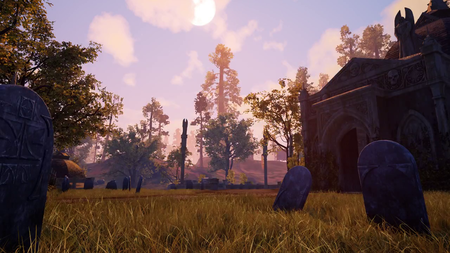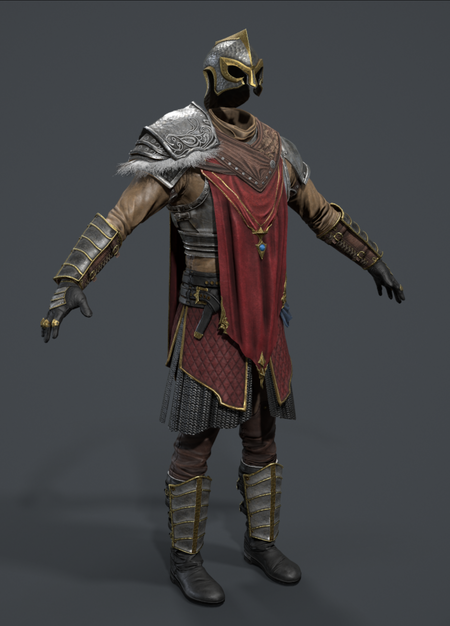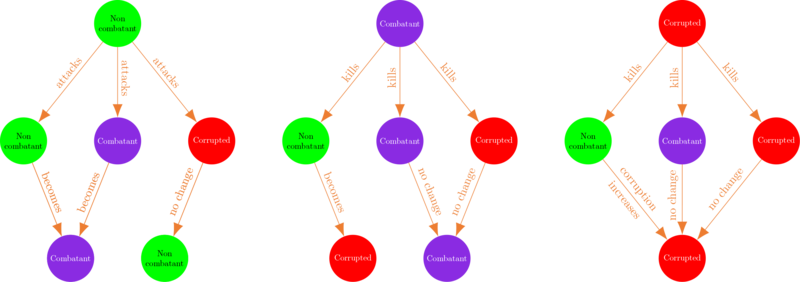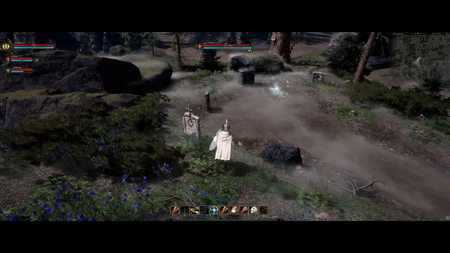Corrupción del jugador
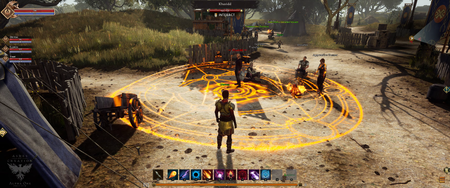
When you gain that corruption you have the potential of losing your completed items, your weapon, your armor, stuff that is very difficult to achieve; and then the other aspect of that is, that in order to deter basically players taking alternate characters and saying this is my PK alt, the more players you kill, the more corruption you gain, the higher your combat efficacy in PVP diminishes. If you're out there and you killed 20 players... you will not be able to perform in PVP any longer. You will need to take that character and go work off that corruption. The other aspect of corruption is that if you kill another player, who is a non-combatant and the level disparity between you and that player is great, you will gain a higher amount of corruption from that single kill. To the point where you should not be killing a level one character.[2] – Steven Sharif
Si un personaje combatiente (morado) o su invocación, mata a un personaje no combatiente (verde), o a cualquiera de sus unidades controladas, en PvP de mundo abierto, será marcado como corrupto (rojo).[3][4][5] La corrupción obtenida por matar entidades controladas tiene un valor inferior al de matar jugadores.[3]
- El objetivo del sistema de corrupción es mantener vivo el riesgo y, al mismo tiempo, restringir o disuadir significativamente la capacidad de los jugadores para griefear otros jugadores.[6][7]
- It is my expectation that the system will perform very well in keeping risk alive, but significantly curtailing or deterring the ability for players to grief.[7] – Steven Sharif
- La puntuación de corrupción de un jugador (valor de corrupción) aumenta con cada jugador no combatiente muerto.[6][8][9][10] La puntuación de corrupción tiene un impacto gradual en la eficacia de las habilidades de un personaje en combate Pvp .[11][12] Cuanto mayor sea la puntuación de corrupción:
- Más se reducen las habilidades y estadísticas (menos salud y maná, menos competencia con el equipo), hasta que el jugador corrupto se vuelve ineficaz en el combate..[11][6][13][2][14][15] This dampening only affects Pvp combat.[16]
- The more corruption you gain, the less effective you become in PvP and there's going to be a certain period at which point you have gained enough corruption that you're going to be gearless and you're also going to have a massive reduction in your PvP efficacy.[14] – Steven Sharif
- Mayor probabilidad de que caigan materias primas y equipo (armas y armadura) al morir el jugador corrupto.[6][9][2][17][14]
- If you go on a murder spree and you have 10 pks under your belt then you might start feeling a significant dampening to your skill effects against other players. I don't want to give necessarily a number or curve for players to extrapolate prior to us having the ability to actually test these ideas and where those numbers are going to lie; but I would say what is the intent behind that dampening: The intent isn't to limit the fun of the player, the intent is to provide a give-and-take or a risk-versus-reward; and the risk of continuing down the road of accruing corruption is not only the loss of your gear and amplified death effects but also your ability to perform in that activity.[18] – Steven Sharif
- Las penalizaciones por corrupción se producen a medida que se va ganando.[19]
- Reward without risk is meaningless... Corruption is just another word for risk.[20] – Steven Sharif
- Cuanto mayor sea la disparidad de nivel entre los jugadores, y cuanto más alto sea el valor de PK del atacante, más corrupción ganará..[6][13][8][9][10]
- Corruption value from PK'ing a non-combatant is based on level disparity along with the PKer's cumulative PK value.[8] – Steven Sharif
- Los jugadores corruptos sufren penalizaciones de muerte cuatro veces superiores a las de los no combatientes.[6][9]
- You can't necessarily time perfectly the damage or understand even the health of the player. Unless you were in their party you cannot see an opponent's health as well, so that's another component that adds risk..[21] – Steven Sharif
- Los jugadores corruptos pueden ser atacados independientemente de otras afiliaciones. Esto es algo que se probará durante la Alfa-2.[22]
- La ubicación de un jugador corrupto se revela a los cazarrecompensas en sus mapas del mundo.[13][9][27][5]
- Los jugadores corruptos pueden matar cazarrecompensas sin adquirir puntuación de corrupción adicional.[28][29]
- Las penalizaciones de combate de los jugadores corruptos no se aplican cuando luchan contra cazarrecompensas.[28]
- El comercio entre jugadores, la interacción con vendedores o PNJs, y la posibilidad de acceder a los almacenes está deshabilitados para los jugadores corruptos.[30][6][31]
- Anteriormente se había dicho que los jugadores corruptos no podrían almacenar objetos en los almacenes públicos pero que si que podrían usar los almacenes privados de sus freeholds.[6][31]
- Los jugadores corruptos podrán utilizar el almacenamiento privado en sus parcelas (Freeholds).[31]
- Hay un temporizador de 60 segundos para desconectarse mientras se es corrupto. Forzar la desconexión del cliente durante el tiempo de enfriamiento dejará al personaje dentro del juego.[11][32]
- Q: Will there be any large-scale consequences when many players in a group guild region religion etc become corrupted frequently or for an extended period of time?
- A: There are not group dynamics or mechanics that revolve around mass murdering people in the world. The corruption system is intended to deter mass murdering, not to provide incentives by which players can go out and gain corruption.[33] – Steven Sharif
- Q: If my guild has no one corrupted and your guild is like always killing people and always corrupted, will your guild have repercussions because they're corrupted versus my guild?
- A: No I don't think so either. And the reason why is we want to deter it, but we don't want to make the system meaningless; and if the deterrent becomes too heavy-handed then it's a system without a purpose. And I think that the intent behind the corruption is that like during a rise in passion and like anger and whatever you want to make this decision and do something and you'll suffer the repercussions later. But if those repercussions are just overwhelmingly bad and even anti-social in the sense that like your guild is like hey man you went corrupted and this gives us like corruption points on the guild, and like you're out of here, then people just aren't going to choose to use it; and then at which point might as well just take it out. So I think there's a healthy balance between the type of deterrent used.[34] – Steven Sharif
- Los jugadores no pierden oro al morir, independientemente de su nivel de corrupción.[35]
- La corrupción tiene un efecto visible en la apariencia de un jugador.[36]
Removing corruption
The primary means to remove corruption is through death. Multiple deaths may be necessary to remove all corruption.[38][23]
- Dying removes a significant portion of a player's corruption score.[39]
- Gaining experience will also slowly reduce a player's corruption score.[40][13][38]
- Any experience that's gained by the player, whether it be through achievements in crafting, or in adventuring, or through other types of achievements: All of that experience goes towards your adventuring class experience gained; and then some experience can dual purpose towards professions as well. So if I reach an achievement in my crafting profession and that grants me additional experience within that profession to rank up, it will also grant the same amount of experience over in my adventuring level; and to that point, anytime you gain adventuring experience you tick away at the corruption.[40] – Steven Sharif
- A quest may be utilized to reduce the player kill (PK) count of a corrupt player in order for them to accumulate less corruption score in the future.[41][39]
- Corruption duration is reduced in military nodes.[43]
Cazarrecompensas
Players can acquire the bounty hunter title through a quest available to citizens of Military Stage 4 (Pueblo) nodes and potentially their vassals or affiliated nodes.[44][10]
- Bounty hunters can activate their Rastrear ability to reveal corrupted player locations on their map.[45][46]
- This will flag the bounty hunter for combat only to corrupted players for a period of one hour from the time of activation.[45]
- The pathfinding ability can be toggled on or off.[45][47]
- It is possible that bounty hunters will be permanently flagged versus corrupted players with the pathfinding ability toggled off. This design change will be decided based on testing.[48]
- The accuracy of bounty hunter maps is determined by a player's progression in the bounty hunter system.[49]
- Corrupted players may kill bounty hunters without acquiring additional corruption score.[28][29]
- Corrupted player's combat penalties do not apply when battling bounty hunters.[28]
- Chief bounty hunter is a node government title that grants special access to NPCs in a node.[50]
- Credit for killing a corrupted player goes to the bounty hunter who lands the last hit (killing blow). This may be changed to damage contribution in future.[51]
Mapas de los cazarrecompensas
Los jugadores con una puntuación de corrupción lo suficientemente alta serán visibles en el mapa mundial y en los minimapas. Estos jugadores tendrán marcadores colocados en el mapa por un PNJ de un nodo militar de al menos fase 4 (Pueblo), y solo se concederán a jugadores que tengan el título de Cazarrecompensas .[52] La precisión de los mapas de cazarrecompensas viene determinada por la progresión del jugador en el sistema de cazarrecompensas.[49]
Las tabernas son una de las ubicaciones en las que se publicarán las recompensas. A medida que los jugadores ganan corrupción, las tabernas pueden ofrecer recompensas para eliminar a esos jugadores; o tener un área específica limpia de jugadores conflictivos, dando así un POI (punto de interés) en el mapa del mundo.[53]
Habilidad de rastreador del cazarrecompensas
| Habilidad | Icono | Rango 1 | Rango 2 | Rango 3 |
|---|---|---|---|---|
| Rastrear | Reveals corrupted player locations on the bounty hunter's map.[45][54] Activating this ability will flag the bounty hunter for combat only to corrupted players for a period of one hour from the time of activation.[45] The pathfinding ability can be toggled on or off.[45][47] | The accuracy of the pathfinding skill is determined by a player's progression in the bounty hunter system.[55] | The accuracy of the pathfinding skill is determined by a player's progression in the bounty hunter system.[55] |
Corrupt players killing bounty hunters
Corrupted players potentially gain rewards for killing bounty hunters.[56]
NPC guards
NPC guards will kill corrupted players on sight.[58]
- NPC guards are capable of being killed, but they have high skill levels, damage mitigation, and power levels.[59]
- Guards are capable of being killed. However, that is a very tall barrier to surpass; meaning that their skill level is relatively high. Their damage mitigation, their output, and power: those things are very difficult to overcome. But they can be killed; and again you can upgrade guards through policies, through upgrades within the barracks structures; and you can even place mercenaries and guards ahead of certain events.[59] – Steven Sharif
- Alcaldes of nodes can unlock higher tier NPC guards through policies or by upgrading their barracks service building.[59][60][61][62]
- NPC guards may be available for hire to defend freeholds after a successful node siege.[63] NPC guards that permanently exist on a freehold are not a planned feature.[64]
Marcado de jugadores (Flagging)
El sistema de marcado de Pvp en mundo abierto está diseñado para disuadir a la gente de grifear a otros jugadores.[5]
- Los jugadores pueden participar en PvP en mundo abierto sin tener que recurrir al asesinato.[65]
- Los jugadores gankearán a otros jugadores, pero la intención es que Ashes of Creation no sea una "gank box".
- Las penalizaciones pretenden ser lo suficientemente severas como para disuadir de cualquier tipo de campeo.[66]
- Las invocaciones siguenlas mismas reglas de marcado de PvP que los jugadores y comparten el estado de marcado del jugador.[4][67]
Hay tres niveles de marcado (flagging) para el PvP de mundo abierto en Ashes of Creation.[10]
- No combatiente (verde)
- Todos los jugadores empiezan como no combatientes.[23]
- Los ataques no forzados, incluyendo AoE y efectos de estado, no afectarán a jugadores no combatientes.[68][69]
- Los jugadores verdes que mueres a manos de un mob (el mob asesta el golpe mortal) no marcan a los jugadores atacantes como corruptos, pero como no se conoce la salud exacta de otro jugador (fuera del mismo grupo, raid, alianza, o gremio), los atacantes corren el riesgo de matar al jugador y convertirse en corruptos.[70]
- Las habilidades de jugador con efectos de CC no se aplican a los no combatientes. El objetivo de una habilidad CC debe estar marcado (flagueado) para sufrir los efectos CC. Esto impide, por ejemplo, que los jugadores abran ataques que aturdan a jugadores no combatientes durante un pull.[13]
- No se marcará a los no combatientes por saquear cadáveres.[71]
- Los jugadores podrán optar (a través de una casilla de verificación) por permitir que sus hechizos de AoEs (beneficiosos, o no beneficiosos) golpeen a los combatientes.[72][73]
- If you have that check-box for flagging with your AOEs and heals available then you will flag. If you do not have that box checked then on completion of the skill it will not flag you because the check was made at the start that there was a flagged party member; and then he will not he or she will not receive the beneficial effect as a result or the damage, if it's an offensive spell.[73] – Steven Sharif
- Combatiente (morado)
- Los jugadores son marcados como combatientes si atacan a otro jugador (no corrupto) al realizar un atque forzado. Si el jugador atacado contraataca, también será marcado como combatiente, de lo contrario el jugador atacado permanecerá marcado como no combatiente.[72][74][23]
- Esto también se aplica a los ataques realizados por mascotas de combate, invocaciones, o cualquier otra entidad controlada por el jugador.[4][75]
- Los no combatientes que entran en un campo de batalla de mundo abierto (evento PvP) son marcados automáticamente como combatientes y permanecen marcados durante un periodo de tiempo después de abandonar ese campo de batalla.[10]
- Los no combatientes que curen, potencien, o interactúen de otro modo (positivo) con combatientes o jugadores corruptos serán marcados como combatientes.[11][24][25][26]
- Los jugadores pueden matar combatientes sin repercusiones, y se les anima a hacerlo, ya que morir siendo un combatiente tiene penalizaciones de muerte reducida.[23]
- Los jugadores no pueden cambiar manualmente su estado de marcado a combatiente.[74]
- Los jugadores permanecen marcados durante 90 segundos tras su último ataque a un no combatiente o a otro combatiente.[76]
- Los jugadores no pueden desconectarse mientras estén marcados como combatientes.[32]
- Los jugadores son marcados como combatientes si atacan a otro jugador (no corrupto) al realizar un atque forzado. Si el jugador atacado contraataca, también será marcado como combatiente, de lo contrario el jugador atacado permanecerá marcado como no combatiente.[72][74][23]
- You're not going to see griefing in the game very often; and that's because our flagging system. The corruption mechanics are based around disincentivizing a griefer or PKer but still offering the opportunity, should the occasion arise, where the benefits outweigh the risk, you have the ability to do so. If you gain corruption, which is killing a non-combatant - a player who is not fighting back basically - if you gain that corruption, your world has changed. It is not going to be a very beneficial place to be and you have the potential of losing your gear. Your combat efficacy decreases based on the amount of corruption you accrue. It is a comfortable balance between player agency and grief and basically removing player agency for other players.[77] – Steven Sharif
- Corrupto (rojo)
- Si un jugador combatiente, o su invocación, mata a un jugador no combatiente, incluyendo cualquiera de sus unidades controladas, como su mascota de batalla, montura, o invocación, el personaje del jugador será marcado como corrupto.[3][4][5]
- La corrupción obtenida por matar unidades controladas tiene un valor inferior al de matar a los jugadores.[3]
- El valor de PK de un personaje aumenta con cada jugador no combatiente asesinado a lo largo de la vida de ese personaje.[6][13][8][9][10]
- Cuanto mayor sea la disparidad de niveles entre los jugadores, y cuanto mayor sea el valor PK del atacante, más puntuación de corrupción ganará.[6][13][8][9][10]
- La puntuación de corrupción de un personaje multiplica sus penalizaciones por muerte y revela su ubicación a los cazarrecompensas.[5]
- Si un no combatiente ataca a un jugador corrupto, el no combatiente no se marcará como combatiente.[23]
- Los jugadores corruptos pueden matar cazarrecompensas sin adquirir puntuación de corrupción adicional.[29]
- Hay un temporizador de 60 segundos para desconectarse mientras se está corrupto. Forzar la desconexión del cliente durante el tiempo de enfriamiento dejará al personaje dentro del juego.[11][32]
- Si un jugador combatiente, o su invocación, mata a un jugador no combatiente, incluyendo cualquiera de sus unidades controladas, como su mascota de batalla, montura, o invocación, el personaje del jugador será marcado como corrupto.[3][4][5]
- It's important to note that the idea is going to be that, unless a player is in your party, alliance, guild, or raid that you will not have definitive knowledge of their exact hit point values. So when you do something that's sketchy like that, where you want to bring them close to death and let a monster finish him off, you are taking the risk of overhitting and actually gaining the corruption.[70] – Steven Sharif
- Los eventos PvP basados en objetivos no emplean el sistema de marcado.[6][78]
Differences from other games
Aunque Ashes of Creation se inspira en Lineage II (y otros juegos) también ha corregido varios fallos en la implementación de esos juegos.[80][13][27][81] El planteamiento del sistema de marcado (flaggin) en Ashes of Creation es desincentivar aún más el "griefing" y, al mismo tiempo, permitir que el sistema mantenga el riesgo en el entorno de mundo abierto.[80]
First and foremost, PvP in Ashes exists in both opt-in systems and events, as well as our open world flagging system. And while it is true that I enjoyed and took much inspiration from games like Lineage 2, we have innovated and adapted our approach to Ashes’ flagging system in order to further disincentivize griefing while still allowing the system to keep risk relevant in the open world setting. The overwhelming majority of player’s experiences with PvP in Ashes will be through consensual systems like caravans, sieges, wars, the open sea and other events. Players will make a choice to participate in those systems or not. And if they choose to participate there will be significant rewards for success.[80] – Steven Sharif
- El Pvp en Ashes of Creation existe tanto en sistemas de participación voluntaria (por objetivos) y en eventos como en PvP de mundo abierto con un sistema de marcado (y corrupción).[80]
In the open world, when competing for the scarcity of resources, raids, dungeons and or hunting grounds, an important element of risk vs reward is introduced through our flagging system. Players must be aware of their surroundings and the reputation of other players who may be in proximity. The flagging system is intended to always provide an element of risk in all settings, but also architected to ensure that griefing and PK’ing is almost never worth it. The subtleties of this system are complex, which is of course why it will require considerable testing and feedback.[80] – Steven Sharif
- La acumulación de corrupción tiene en cuenta la diferencia de nivel entre el atacante y el jugador asesinado. Cuanto mayor sea esta, mayor será la corrupción acumulada.[13][8][9][12][10] Las penalizaciones por corrupción se producen a medida que se gana corrupción.[19]
These are all things that I've changed in the system that help to safeguard some of those loopholes. Now of course, as we said, we can't and we don't want to 100% remove the ability for that risk to be alive- for that risk to be realized. But what we do want to do is make sure that those occasions are few and infrequent, and are not the majority of a player experience, let's say in the open world; and we do so by incorporating all of those risks and costs into a decision to gain corruption and then PK another player in the open world. It's just not going to be done often and that is my expectation and opinion. It's also the goal of the system is that griefing is not a viable option or play style. And as a result of that desire for the system, we will fine tune it in such a way through testing that that outcome is achieved. And that is the intent and purpose of the design.[11] – Steven Sharif
- Aumentar la puntuación de corrupción añade niveles progresivos de debilitación de habilidades para el combate PvP.[13][27][81][8][9][10]
- Eliminar la corrupción ganando experiencia lleva mucho más tiempo que en Lineage II.[13]
- También hay un sistema de recompensas que revela la localización de jugadores corruptos en el mapa.[13][27][38][23]
- Las habilidades con efectos de CC no se aplican a los noo-combatientes. Esto impide que los jugadores inicien ataques que aturdan a los jugadores no marcados.[13]
- Los jugadores que curen, potencien, o apoyen de otro modo a jugadores corruptos serán marcados como combatientes.[11][24][25][26]
- La puntuación de la corrupción tiene un impacto gradual en el debilitamiento de habilidades y estadísticas que, en última instancia, los hará ineficaces en PvP.[11][6][12][13][2][14][15] Este debilitamiento solo afecta al combate Pvp.[16]
- Hay un temporizador de 60 segundos para desconectarse mientras se está corrupto. Forzar la desconexión del cliente durante el enfriamiento dejará al personaje en el juego hasta que pase ese tiempo.[11][32]
Muerte del personaje
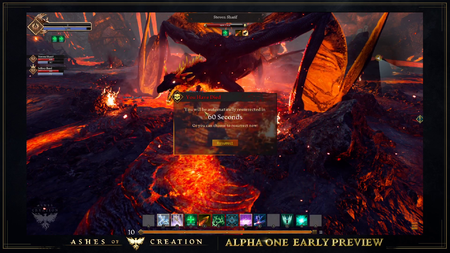
We don't have deleveling, instead what we have is experience debt. Now the more experience debt you accrue, the greater the detriment to your character; not to the point where you can not get out of the debt. There will always be a way forward to remove your debt.[77] – Steven Sharif
Cuando un personaje muere se se desintegra en cenizas. Las cenizas contienen cualquier objeto cualquier objeto perdido por el jugador debido a las penalizaciones por muerte correspondientes.[83][84][85][15][86] Estos montones de ceniza son saqueables de forma inmediata por cualquier jugador.[84] El marcado de jugadores (flagging) no se activa al saquear.[71]
- Un no combatiente (jugador verde) que muere sufre las penalizaciones normales, incluyendo:[15]
- Deuda de experiencia (experiencia negativa).[87]
- Pérdida de durabilidad.[89][90][15]
- When players die and they take durability loss, our durability loss isn't like other games where it's a gold sink so to speak. It's a combination of both a gold sink and a material sink. So in a sense, even if you only have completed items, when you take that durability loss you are losing out on materials. It's just a debt to the materials that you are losing instead of the active loss of that material in your inventory. So now you are accruing a material debt if you want to repair and increase again the performance of those particular items that take that durability loss.[89] – Steven Sharif
- Se suelta un porcentaje de los objetos recolectables y materiales que se usan en la creación de otros objetos.[91][85][15]
- Los objetos destinados al consumo final no se pierden, como los objetos consumibles creador por las profesiones de cocina y alquimia.[91]
- También se dejan caer un porcentaje de los certificados que lleva el jugador.[86]
- Si un jugador muere, habrá un periodo de tiempo antes de que su mula desaparezca. Otros jugadores deberán matar a la mula de ese jugador para poder saquearla.[92]
- Si la mula de un jugador muere, su cadáver tendrá el mismo porcentaje de objetos que el jugador..[92][93]
- Un combatiente (jugador púrpura) que muere sufre estas mismas penalizaciones, pero al 50% que un no combatiente.[15]
- Un corrupto (jugador rojo) sufre penalizaciones cuatro veces superiores a las de un no combatiente, y tiene la posibilidad de soltar cualquier objeto que lleve equipado en función de su puntuación de corrupción actual.Esto incluye:[6][9] This includes:[9][15]
- Any amount of corruption allows a player to drop equipped gear upon death. The higher the corruption the greater the chances.[94] – Steven Sharif
- Estos objetos pueden ser saqueados por otros jugadores.[95]
- Los jugadores corruptos reaparecen en lugares aleatorios en las proximidades de su muerte, no en los puntos de reaparición habituales.[46]
- Los jugadores no corruptos siempre reaparecen en el punto de reaparición activo más cercano (a su muerte).[96]
- Las penaliazciones por corrupción se acumulan a medida que se gana corrupción (no sólo al morir).[19]
- La deuda de experiencia escalará aproximadamente al 2 o 3 por ciento de la XP total para un jugador de nivel máximo. Estas cifras están sujetas a cambios en función de las pruebas.[97]
- Las penalizaciones por muerte (en su mayoría) no se aplican al PvP basado en objetivos.[98][99][100]
- There will not be death penalties applied to event-based deaths. The penalties are in the outcome of the event. So your number of deaths is likely going to impact your ability to win that particular event and that's going to be the penalty. This is it to encourage players to opt in to the events right because the more participation we have the more fun it can be; and we understand that the community at large- there's already a risk versus reward component to these events. We don't need to stack on additional risk versus reward to inhibit kind of- to increase the barrier to entry for players who may not be as interested.[100] – Steven Sharif
- La degradación de equipo se aplica al morir durante el PvP de caravanas.[98][99]
La muerte por caída es posible.[102]
- El daño por caída que ocurra mientras se está montado se aplicará primero a la montura; y si la montura muere como resultado, entonces el daño restante puede pasar al jugador, pero esto se determinará en función de las pruebas.[102]
La muerte por ahogamiento es posible.[103][104]
- Los jugadores que se ahoguen resurgirán en la orilla.[103]
Si un jugador muere habrá un periodo de tiempo antes de que su mula desaparezca. Otros jugadores deberán matar la mula de ese jugador para poder saquearla.[92]
- Si la mula de un jugador muere su cadáver tendrá el mismo porcentaje de objetos de botín que el jugador.[92][93]
Los jugadores no pierden oro al morir, independientemente de su nivel de corrupción.[35]
- At the moment, the plan is for players to not lose gold upon death, no matter their corruption level.[35] – Cody Peterson
Death penalties

We don't have deleveling, instead what we have is experience debt. Now the more experience debt you accrue, the greater the detriment to your character; not to the point where you can not get out of the debt. There will always be a way forward to remove your debt.[77] – Steven Sharif
- Non-combatant (green players) suffer normal death penalties, which include:[15]
- Experience debt (negative experience). Experience debt scales to approximately 3 to 4 percent of the total XP for that level (subject to change based on testing).[105][87]
- Skill and stat dampening, such as Lower health and mana.[105][11][6][13][2][14]
- Reduction in loot drop rates from mobs.[88]
- Durability loss.[89][90][15]
- When players die and they take durability loss, our durability loss isn't like other games where it's a gold sink so to speak. It's a combination of both a gold sink and a material sink. So in a sense, even if you only have completed items, when you take that durability loss you are losing out on materials. It's just a debt to the materials that you are losing instead of the active loss of that material in your inventory. So now you are accruing a material debt if you want to repair and increase again the performance of those particular items that take that durability loss.[89] – Steven Sharif
- Dropping roughly 20-30% of carried gatherables, materials, and glint. The percentage values are subject to change based on Alpha-2 testing.[105][106][91][86][85][15] Glint drops as stolen glint on death.[106]
- Items made for final consumption are not dropped, such as consumable items created by the Cocina and Alquimia professions.[91]
- Combatants (purple players) suffer death penalties at half the rate of non-combatants.[15]
- Corrupt players (red players) suffer death penalties at four times the rate of non-combatants.[6][9]
- Corrupt players also have a chance to drop any equipped items based on their current corruption score, including dropping weapons and armor.[9][17][6][9][95][15]
- Any amount of corruption allows a player to drop equipped gear upon death. The higher the corruption the greater the chances.[94] – Steven Sharif
- Corrupt players respawn at random locations in the vicinity of their death, not at regular spawn points.[46] Non-corrupt players always respawn at the closest active respawn point (to their death).[96]
- Corruption penalties occur as the corruption is gained (not just at death).[19]
- Death penalties for corrupt players apply in every location, including naval PvP zones.[107]
Death penalties (mostly) do not apply to objective-based PvP (also called sanctioned events).[108][98][99][100]
- There will not be death penalties applied to event-based deaths. The penalties are in the outcome of the event. So your number of deaths is likely going to impact your ability to win that particular event and that's going to be the penalty. This is it to encourage players to opt in to the events right because the more participation we have the more fun it can be; and we understand that the community at large- there's already a risk versus reward component to these events. We don't need to stack on additional risk versus reward to inhibit kind of- to increase the barrier to entry for players who may not be as interested.[100] – Steven Sharif
- Gear degradation applies on death during PvP de caravanas.[98][99]
- Previously it was stated that death penalties do not differ between Pvp and PvE.[101]
Non-corrupt players suffer reduced death penalties in naval PvP (open seas) zones.[107]
- These penalties will be less than those for a green player.[109]
- Q: We know that the normal death penalty incurs a myriad of penalties for the player, but we don't know the numbers behind this penalty. For instance, what percentage of materials do players drop? What percentage of glint is dropped? How severe is the skill and stat dampening? What is the average time it will take a player to work off XP debt from one death?
- A: You're asking about percentile values. You're asking about time that it takes to recoup the percentage and whatnot. Any time that we're at a stage we're in now, and that in Alpha-2 we're going to be testing this, those values are the most subject to change. So to be clear, we're going to do [a] best-guess balance pass for Alpha-2 with the full expectation and understanding that the purpose is- and take into consideration player interaction with those numbers, and what feels best. So just off the bat, those values are not what we should be focusing on at this stage; but, to give you an idea where we are: First of all, when we're talking about dropping items that are in your material inventory, whether that be glint or that be other material types, we're talking roughly between anywhere from 20 to 30% of a stack is going to be lootable on a per-death basis. Now, that is a value that can change based off of the types of bags that you are using to carry those materials. In addition, there's other progression that can allow you, and some stats I believe, that can allow you to mitigate that value also. When we are talking about the percentage that's lost, or excuse me, not lost, the percentage of your level that is accrued as experience debt from death, generally you can expect that that's going to live around three to four percent of the level in accrued experience debt per death. However, additionally, there is a way to mitigate that percentage debt; and that is through the resurrection ability that's provided to Clerics. So, Clerics have the ability to resurrect their allies, and that resurrection will return a percentage that would have been accrued as experience debt. And that return percentage is predicated on the investment into the resability [sic], as well as the stat of the Cleric that is tied to the resurrection effect as well. So those can return percentages, so you can mitigate that to a degree. How long will it take you to recover that, and what stat dampening occurs? Anywhere within a level, if you acquire 100% experience debt for that level, you max out the experience debt, essentially, you don't ever buy that down, you're probably looking around a 20% stat efficacy dampener. So on average, if you're at 100% debt for a level, and you got to work all that off before you can start progressing at the level again, you're at around 20% overall stat dampening. Time it takes you to regain that debt is predicated on the level you're at and how you exp. So, that's a highly variable value.[105] – Steven Sharif
- Reduction in gear proficiency.[15]
Skill and stat dampening
Skill and stat dampening penalties are applied when a player dies or when they gain corruption. This causes negative effects, such as a reduction of health and mana.[11][6][13][2][14]
- Reaching maximum experience debt for a level can result in roughly 20% stat dampening for that character. This percentage is expected to be highly variable.[105]
- Anywhere within a level, if you acquire 100% experience debt for that level, you max out the experience debt, essentially, you don't ever buy that down, you're probably looking around a 20% stat efficacy dampener. So on average, if you're at 100% debt for a level, and you got to work all that off before you can start progressing at the level again, you're at around 20% overall stat dampening. Time it takes you to regain that debt is predicated on the level you're at and how you exp. So, that's a highly variable value.[105] – Steven Sharif
- Non-combatant players accrue skill and stat dampening on death at twice the rate of combatants.[11][6][13][2][14]
- Corrupted players gain skill and stat dampening as soon as corruption is gained. This increases each time corruption is gained until they ultimately become ineffective at Pvp combat.[19][8][11][6][13][9][27][81][16][2][14][15]
Respawn locations
Non-corrupt players always respawn at the closest active respawn point (to their death).[96]
- Corrupt players respawn at random locations in the vicinity of their death, not at regular spawn points.[46]
- There will not be custom respawn points that can be placed in the world.[111]
- Events in progress may disable certain respawn points in proximity to those events, which might cause players to respawn further away.[96]
- That has to do with the lore behind death and resurrection and what it means to have your soul connected as a conduit of that spark of life given from the Goddess of Creation, being that phoenix type of avatar; and if corruption has moved into an area and an event has started, the access to those ley line oriented respawn points may be obscured- might not be accessible. So that could create some additional distance that needs to be traveled as part of these types of events.[96] – Steven Sharif
Ver además
Referencias
- ↑ Vídeo, 2020-05-31 (5:29).
- ↑ 2.0 2.1 2.2 2.3 2.4 2.5 2.6 2.7 Pódcast, 2018-04-23 (51:31).
- ↑ 3.0 3.1 3.2 3.3 Transmisión en vivo, 2022-10-28 (1:35:36).
- ↑ 4.0 4.1 4.2 4.3

- ↑ 5.0 5.1 5.2 5.3 5.4

- ↑ 6.00 6.01 6.02 6.03 6.04 6.05 6.06 6.07 6.08 6.09 6.10 6.11 6.12 6.13 6.14 6.15 6.16 6.17 6.18 Transmisión en vivo, 2022-10-28 (24:28).
- ↑ 7.0 7.1 Transmisión en vivo, 2022-10-28 (13:53).
- ↑ 8.0 8.1 8.2 8.3 8.4 8.5 8.6 8.7

- ↑ 9.00 9.01 9.02 9.03 9.04 9.05 9.06 9.07 9.08 9.09 9.10 9.11 9.12 9.13 9.14 9.15 Entrevista, 2020-07-18 (41:54).
- ↑ 10.0 10.1 10.2 10.3 10.4 10.5 10.6 10.7 10.8 MMOGames interview, January 2017
- ↑ 11.00 11.01 11.02 11.03 11.04 11.05 11.06 11.07 11.08 11.09 11.10 11.11 11.12 11.13 11.14 11.15 Transmisión en vivo, 2022-10-28 (26:48).
- ↑ 12.0 12.1 12.2

- ↑ 13.00 13.01 13.02 13.03 13.04 13.05 13.06 13.07 13.08 13.09 13.10 13.11 13.12 13.13 13.14 13.15 13.16 13.17
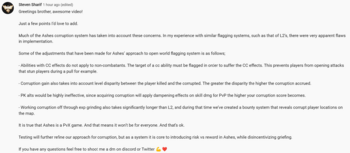
- ↑ 14.0 14.1 14.2 14.3 14.4 14.5 14.6 14.7 Transmisión en vivo, 2017-05-22 (42:33).
- ↑ 15.00 15.01 15.02 15.03 15.04 15.05 15.06 15.07 15.08 15.09 15.10 15.11 15.12 15.13 15.14 15.15 15.16 15.17 Pódcast, 2017-05-05 (43:05).
- ↑ 16.0 16.1 16.2 Entrevista, 2018-05-11 (5:05).
- ↑ 17.0 17.1 17.2 Transmisión en vivo, 2017-11-17 (35:20).
- ↑ Pódcast, 2021-04-11 (38:31).
- ↑ 19.0 19.1 19.2 19.3 19.4
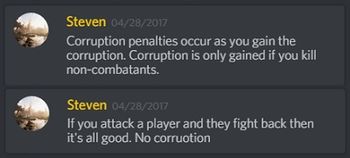
- ↑
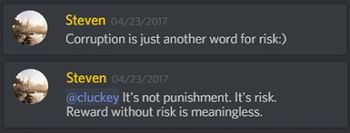
- ↑ Transmisión en vivo, 2020-01-30 (1:40:48).
- ↑ Transmisión en vivo, 2022-07-29 (1:07:20).
- ↑ 23.0 23.1 23.2 23.3 23.4 23.5 23.6 23.7 Entrevista, 2017-04-27 (0:17).
- ↑ 24.0 24.1 24.2

- ↑ 25.0 25.1 25.2 Entrevista, 2019-04-22 (54:40).
- ↑ 26.0 26.1 26.2 Transmisión en vivo, 2017-11-17 (29:45).
- ↑ 27.0 27.1 27.2 27.3 27.4

- ↑ 28.0 28.1 28.2 28.3

- ↑ 29.0 29.1 29.2 Entrevista, 2017-04-27 (1:18).
- ↑ Transmisión en vivo, 2023-02-24 (1:12:24).
- ↑ 31.0 31.1 31.2 Transmisión en vivo, 2021-04-30 (1:14:49).
- ↑ 32.0 32.1 32.2 32.3

- ↑ Transmisión en vivo, 2021-08-27 (1:20:09).
- ↑ Transmisión en vivo, 2021-08-27 (1:20:51).
- ↑ 35.0 35.1 35.2
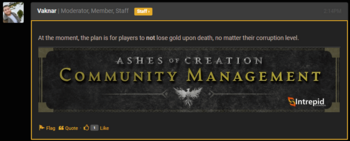
- ↑ Entrevista, 2017-02-01 (39:33).
- ↑ Transmisión en vivo, 2018-07-09 (20:41).
- ↑ 38.0 38.1 38.2 Entrevista, 2020-07-18 (44:35).
- ↑ 39.0 39.1 Entrevista, 2020-07-19 (30:51).
- ↑ 40.0 40.1 Transmisión en vivo, 2023-04-28 (1:27:18).
- ↑

- ↑ Transmisión en vivo, 2018-06-04 (2:18).
- ↑
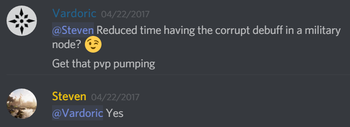
- ↑ Transmisión en vivo, 2020-06-26 (1:50:24).
- ↑ 45.0 45.1 45.2 45.3 45.4 45.5

- ↑ 46.0 46.1 46.2 46.3 Entrevista, 2017-04-27 (9:28).
- ↑ 47.0 47.1
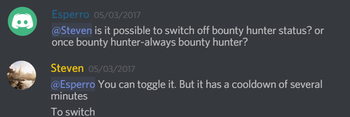
- ↑

- ↑ 49.0 49.1 Transmisión en vivo, 2017-05-24 (48:00).
- ↑ Transmisión en vivo, 2019-07-26 (1:20:48).
- ↑ Transmisión en vivo, 2021-06-25 (1:06:22).
- ↑ Entrevista, 2017-01-20 (06:12).
- ↑ The mighty beard!
- ↑ Entrevista, 2017-04-27 (9:28).
- ↑ 55.0 55.1 Transmisión en vivo, 2017-05-24 (48:00).
- ↑ Entrevista, 2018-10-20 (15:51).
- ↑

- ↑ Transmisión en vivo, 2020-02-28 (1:14:38).
- ↑ 59.0 59.1 59.2 Transmisión en vivo, 2023-08-31 (2:08:54).
- ↑ Transmisión en vivo, 2023-08-31 (2:06:21).
- ↑ Transmisión en vivo, 2023-04-07 (1:19:41).
- ↑ Transmisión en vivo, 2022-08-26 (1:17:04).
- ↑ Transmisión en vivo, 2017-05-19 (28:04).
- ↑ Transmisión en vivo, 2018-01-18 (31:05).
- ↑ Transmisión en vivo, 2017-05-12 (24:52).
- ↑

- ↑

- ↑ Transmisión en vivo, 2022-10-28 (1:34:52).
- ↑

- ↑ 70.0 70.1 Transmisión en vivo, 2021-07-30 (1:10:34).
- ↑ 71.0 71.1 Pódcast, 2021-04-11 (34:41).
- ↑ 72.0 72.1 Transmisión en vivo, 2022-12-02 (2:41).
- ↑ 73.0 73.1 Entrevista, 2020-07-08 (1:05:27).
- ↑ 74.0 74.1 Transmisión en vivo, 2020-11-30 (1:09:06).
- ↑ Transmisión en vivo, 2018-10-31 (44:12).
- ↑

- ↑ 77.0 77.1 77.2 Pódcast, 2018-04-23 (49:21).
- ↑

- ↑
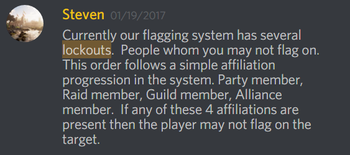
- ↑ 80.0 80.1 80.2 80.3 80.4
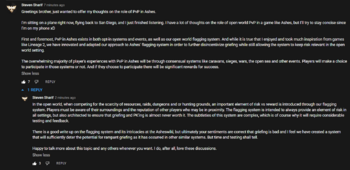
- ↑ 81.0 81.1 81.2 Entrevista, 2018-08-24 (8:35).
- ↑ 82.0 82.1 Transmisión en vivo, 2020-03-28 (1:58:24).
- ↑ Transmisión en vivo, 2021-09-24 (51:20).
- ↑ 84.0 84.1 Transmisión en vivo, 2021-03-26 (1:07:33).
- ↑ 85.0 85.1 85.2

- ↑ 86.0 86.1 86.2 Entrevista, 2020-07-18 (27:11).
- ↑ 87.0 87.1 Transmisión en vivo, 2017-05-19 (13:37).
- ↑ 88.0 88.1 Ashes of Creation Forums - Former Lineage 2 PvP'er wanting to discuss PvP loopholes.
- ↑ 89.0 89.1 89.2 89.3 Entrevista, 2021-02-07 (13:14).
- ↑ 90.0 90.1 Entrevista, 2020-07-29 (16:46).
- ↑ 91.0 91.1 91.2 91.3 Transmisión en vivo, 2022-12-02 (1:26:02).
- ↑ 92.0 92.1 92.2 92.3 Transmisión en vivo, 2021-01-29 (1:24:27).
- ↑ 93.0 93.1 Transmisión en vivo, 2018-09-27 (47:46).
- ↑ 94.0 94.1

- ↑ 95.0 95.1 Entrevista, 2018-05-11 (15:41).
- ↑ 96.0 96.1 96.2 96.3 96.4 Transmisión en vivo, 2021-06-25 (1:15:37).
- ↑ Transmisión en vivo, 2021-05-28 (1:50:50).
- ↑ 98.0 98.1 98.2 98.3 Transmisión en vivo, 2022-06-30 (1:14:52).
- ↑ 99.0 99.1 99.2 99.3 Transmisión en vivo, 2021-08-27 (1:22:56).
- ↑ 100.0 100.1 100.2 100.3 Transmisión en vivo, 2020-12-22 (1:13:51).
- ↑ 101.0 101.1 Transmisión en vivo, 2017-05-15 (36:23).
- ↑ 102.0 102.1 Transmisión en vivo, 2022-02-25 (1:06:45).
- ↑ 103.0 103.1 Transmisión en vivo, 2022-04-29 (1:08:27).
- ↑ Transmisión en vivo, 2017-07-28 (50:22).
- ↑ 105.0 105.1 105.2 105.3 105.4 105.5 Transmisión en vivo, 2024-03-29 (3:21).
- ↑ 106.0 106.1 Entrevista, 2023-09-10 (53:47).
- ↑ 107.0 107.1 Entrevista, 2023-07-09 (36:56).
- ↑ Transmisión en vivo, 2023-02-24 (1:29:45).
- ↑ Entrevista, 2023-07-09 (38:03).
- ↑ Vídeo, 2022-12-02 (16:29).
- ↑ Transmisión en vivo, 2023-05-31 (1:08:39).
